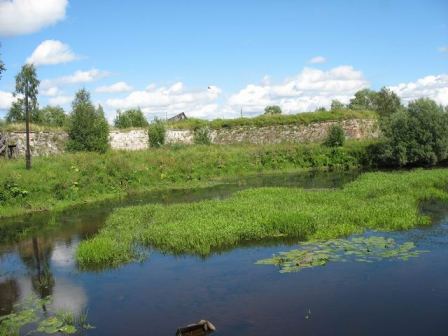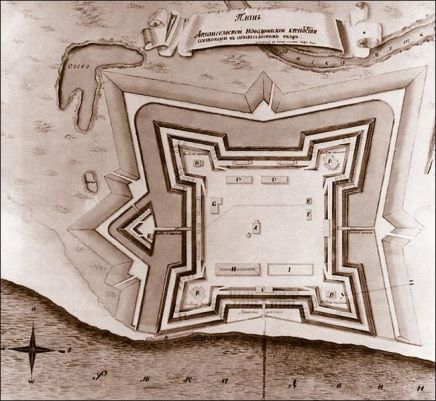

Location: Arkhangelsk Oblast Map
Constructed: 1701

Novodvinsk Fortress is a complex of fortifications in the delta of the Severnaya Dvina River. It is located 20 km north of the center of Arkhangelsk, on the northwestern tip of the island of Linsky Priluk, on the northern outskirts of the village of Conveyor. Administratively belongs to the Maymaksan district of Arkhangelsk. The fortress was founded in 1701 on the personal instructions of Tsar Peter I to protect the Arkhangelsk Waterway in connection with the expected attack of the Swedes (the Northern War of 1700-1721). The author of the project is the German engineer Georg-Ernest Reze.
On December 24, 1700, Tsar Peter indicated to the governor of Dvina,
Prince Alexei Petrovich Prozorovsky
"... near the city of
Archangelsky, on the Malaya Dvinka river, to build a fortress again, a
seat for a thousand people, so that it would be convenient for the
above-mentioned number of people to be in it with magic reserve yards."
The start of construction was scheduled for the spring of 1701.
Fortification engineer Yagan (Johan) Adler was sent to Arkhangelsk to
select a location, draw up drawings and estimates. Peter was not
satisfied with the plan he had drawn up, and at the end of March he sent
a military engineer, a participant in the siege of Azov, Egor Rezen
(Georg Ernest Reze, in Russian service since the mid-1690s) to the
Dvina, who, arriving in Arkhangelsk on April 18, 1701, immediately began
work. They chose a construction site on the island of Linskoy Priluk, 20
versts from Arkhangelsk. On April 3, the tsar established a special
construction management body, the Semigrad Town Hall, which hired
workers, prepared construction materials and inventory, and kept
accounting records. The head of the Semigrad City Hall was the clerk
Fyodor Gusev. The end of April is the beginning of construction work.
Supervision of the construction goes to Peter's colleague, Archbishop of
Kholmogorsky and Vazhsky, His Grace Athanasius. On May 12, Georg Reze
presented a plan for the fortress, and on May 14, work on clearing the
territory was already completed and digging ditches for foundations
began. The economic part of the construction was led by stolnik Ievlev
Seliverst Petrovich. June 12, 1701 — the laying of the fortress. June 13
— Peter signs a decree on the adoption of defensive measures when
Swedish frigates appear in the White Sea, and on June 16 writes a letter
to Archbishop Athanasius on the transfer of exclusive powers to him for
the defense of the White Sea.
Novodvinsk fortress was considered
one of the best fortresses in Russia. The fortifications included a
square four-bastion citadel and a number of so-called external
fortifications: a fossebray, a moat, a ravelin, a covered path, a
palisade and a glacis. Inside the citadel, 2 brick (gatehouse) buildings
were rebuilt to accommodate the commandant and senior officers, 4 powder
magazines, barracks, military ammunition depots, a tower with a flagpole
for raising the fortress flag. On the central parade ground there was a
wooden church in the name of St. Peter and Paul.
On June 25,
1701, when the construction of the fortress was just beginning, the
Swedes launched an attack on Arkhangelsk. The vanguard of the Swedish
squadron, consisting of 3 warships (2 frigates and a yacht) under the
English and Dutch flags, approached the fortress under construction. The
remaining 4 large ships remained off Mudyug Island, awaiting the outcome
of the reconnaissance operation. One of the frigates and a yacht ran
aground due to the shallow depth of the river near the fortress and were
fired from the guns of coastal batteries. After a 13-hour battle, the
Swedes abandoned the frigate and yacht and retreated to another frigate
in boats. The expedition failed, and the Swedes left the mouth of the
Dvina River. Thus, 2 Swedish ships with full weapons and ammunition were
captured — the first war trophies in the Northern War. In many ways,
this victory was facilitated by the selfless actions of two Pomors —
Ivan Ryabov (Sedunov) and Dmitry Popov, who, having been captured a few
days earlier and forced by the Swedes to be guides on pain of death,
misled the captain of the lead ship of the vanguard, as a result of
which two Swedish ships were stranded, directly opposite the coastal
batteries.
The main construction work on the fortress was
completed in 1705; the complete formation of the fortification complex
dates back to 1714, when the construction of the ravelin was completed
on the northern side of the fortress.
During the Crimean War
(1853-1856), although the fortress did not take part in hostilities, its
presence on the way to Arkhangelsk thwarted plans to attack the city by
a combined Anglo-French squadron. The enemy did not dare to enter the
mouth of the Northern Dvina River, fearing the fire of fortress guns.
It was abolished in 1863. Since 1864, it has been under the
jurisdiction of the Archangel Diocese.
In 1911 and 1913, the
Novodvinsk fortress was examined by a group of specialists led by the
founder of the national school of scientific restoration of
architectural monuments, P. P. Pokryshkin. Further work on the study and
restoration of the fortress was prevented by the outbreak of the First
World War.
In Soviet times, a children's colony-commune was first
located on the territory of the fortress, later a correctional labor
institution that existed until 2006. In December 2007, the Novodvinsk
Fortress was transferred to the Arkhangelsk Regional Museum of Local
Lore, and received the status of a monument of federal significance.
Since 2008, emergency work has been carried out on the territory of the
fortress. Currently, the southern and western parts of the citadel with
the complexes of the two main gates are in relatively good condition;
the rest of the fortifications have been preserved in fragments. On
September 10, 2020, it became known about the intention of the
authorities of the Arkhangelsk region to restore the Novodvinsk Fortress
with the support of the Ministry of Culture for the 350th anniversary of
Peter the Great in 2022.
Novodvinskaya Fortress is an interesting place for exploration. It still has many secrets and artifacts hidden in its soil. Its legacy of secret Soviet laboratories makes it further interesting and mysterious. However you should take in consideration that the site did not see any significant archeological digs and was never secured by the engineers. Cave ins and accidents in Novodvinskaya Fortress ruins are possible in the old structures that are still standing and underground tunnel systems.